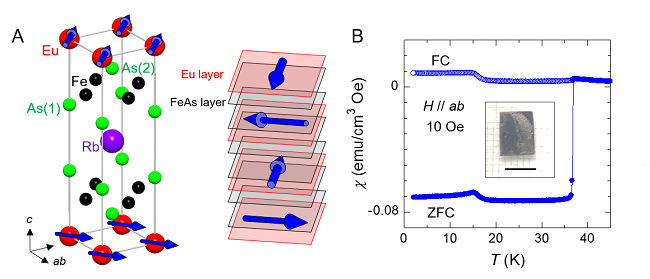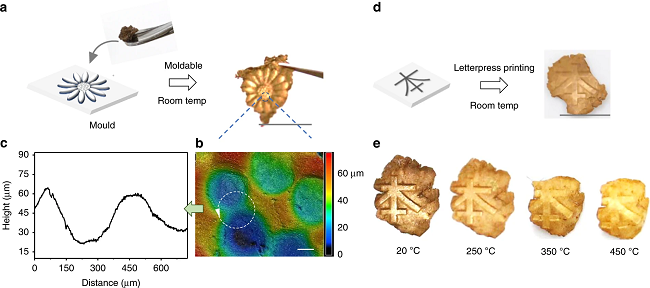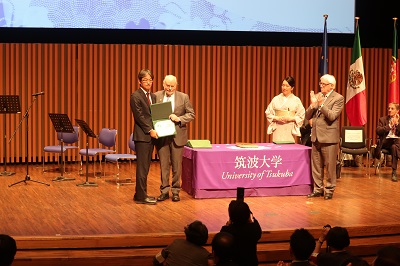PAST TOPICS
2021
Superconductivity-driven ferromagnetism and spin manipulation using vortices in the magnetic superconductor EuRbFe4As4
The interaction between superconductivity and magnetism creates numerous exotic physical phenomena, while the two phenomena rarely coexist in one material due to their antagonistic nature. The recently discovered iron-based magnetic superconductor EuRbFe4As4 shows high-critical-temperature superconductivity and helimagnetic order at the ground state.
Shigeyuki Ishida, Senior Researcher, Hiraku Ogino, Senior Researcher, Akira Iyo, Chief Senior Researcher and Hiroshi Eisaki, Prime Senior Researcher of Superconducting Electronics Group, together with Comprehensive Research Organization for Science and Society (CROSS), TU Wien, and IMRA JAPAN CO., LTD, discovered a phenomenon that the spin orientation is determined by the direction of the superconducting vortices in EuRbFe4As4. Moreover, it was demonstrated that the domain structure of the local spins can be manipulated by the distribution of superconducting vortices. The capability of manipulating the spin texture by controlling the direction of superconducting vortices opens a path to novel devices such as superconducting memories using magnetic superconductors.
For the details, please refer to "Proceedings of the National Academy of Sciences of the United States of America".

The interaction between superconductivity and magnetism creates numerous exotic physical phenomena, while the two phenomena rarely coexist in one material due to their antagonistic nature. The recently discovered iron-based magnetic superconductor EuRbFe4As4 shows high-critical-temperature superconductivity and helimagnetic order at the ground state.
Shigeyuki Ishida, Senior Researcher, Hiraku Ogino, Senior Researcher, Akira Iyo, Chief Senior Researcher and Hiroshi Eisaki, Prime Senior Researcher of Superconducting Electronics Group, together with Comprehensive Research Organization for Science and Society (CROSS), TU Wien, and IMRA JAPAN CO., LTD, discovered a phenomenon that the spin orientation is determined by the direction of the superconducting vortices in EuRbFe4As4. Moreover, it was demonstrated that the domain structure of the local spins can be manipulated by the distribution of superconducting vortices. The capability of manipulating the spin texture by controlling the direction of superconducting vortices opens a path to novel devices such as superconducting memories using magnetic superconductors.
For the details, please refer to "Proceedings of the National Academy of Sciences of the United States of America".

A. Crystal structure of EuRbFe4As4. Blue arrows indicate the direction of the Eu2+ moments in the magnetically ordered state.
B. Temperature dependence of magnetization. Superconducting transition and magnetic ordering ocurr at 36 K and 15 K, respectively.
2020
Gold clay from self-assembly of 2D microscale nanosheets
Youfeng Yue, Senior Researcher, and Yasuo Norikane, Group Leader of Molecular Assembly Group, report the controlled growth of gold nanosheets on bilayer membranes and self-assembly of the nanosheets leads to free-standing gold clay nanostructures.
Single-crystalline Au nanosheets are synthesized by controlled growth in the bilayer membranes of succinic acid surfactants. Then, a self-assembly strategy is used to make {111}-oriented gold nanostructures at the liquid−liquid interface. The stiffness of the nanosheet assemblies are six orders of magnitude softer than bulk gold. The Au nanosheet aggregates show high plasticity and deformable into macroscale free-standing metallic architectures. They show a stress/strain-dependent conductivity owing to morphological changes.
Our study provides valuable insights on the chemical synthesis of 2D nanostructures as well as for the self-assembly strategy on fabrication of mouldable metals for producing free-standing metallic architectures with microscale resolutions.
This finding was published in "Nature Communications" on Jan.29 2020.
Youfeng Yue, Senior Researcher, and Yasuo Norikane, Group Leader of Molecular Assembly Group, report the controlled growth of gold nanosheets on bilayer membranes and self-assembly of the nanosheets leads to free-standing gold clay nanostructures.
Single-crystalline Au nanosheets are synthesized by controlled growth in the bilayer membranes of succinic acid surfactants. Then, a self-assembly strategy is used to make {111}-oriented gold nanostructures at the liquid−liquid interface. The stiffness of the nanosheet assemblies are six orders of magnitude softer than bulk gold. The Au nanosheet aggregates show high plasticity and deformable into macroscale free-standing metallic architectures. They show a stress/strain-dependent conductivity owing to morphological changes.
Our study provides valuable insights on the chemical synthesis of 2D nanostructures as well as for the self-assembly strategy on fabrication of mouldable metals for producing free-standing metallic architectures with microscale resolutions.
This finding was published in "Nature Communications" on Jan.29 2020.

2019
The World Cultural Council (WCC) and the
University of Tsukuba hosted the 36th WCC Award Ceremony from
October 3 to 4, 2019. Kazuhiro Ikeda, Group Leader of Photonics Systems
Group was awarded WCC Special Recognition along with several outstanding
Japanese scholars. The World Cultural Council is a non-profit international
organization and its goal is to promote culture, values and goodwill all
over the world.
Please refer to this site for the more details.

Please refer to this site for the more details.


